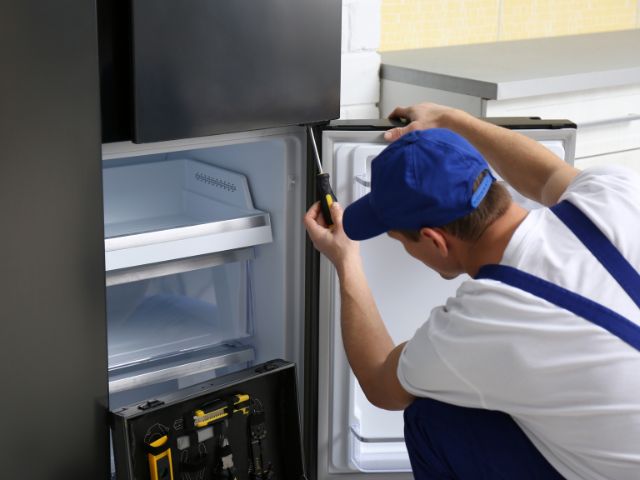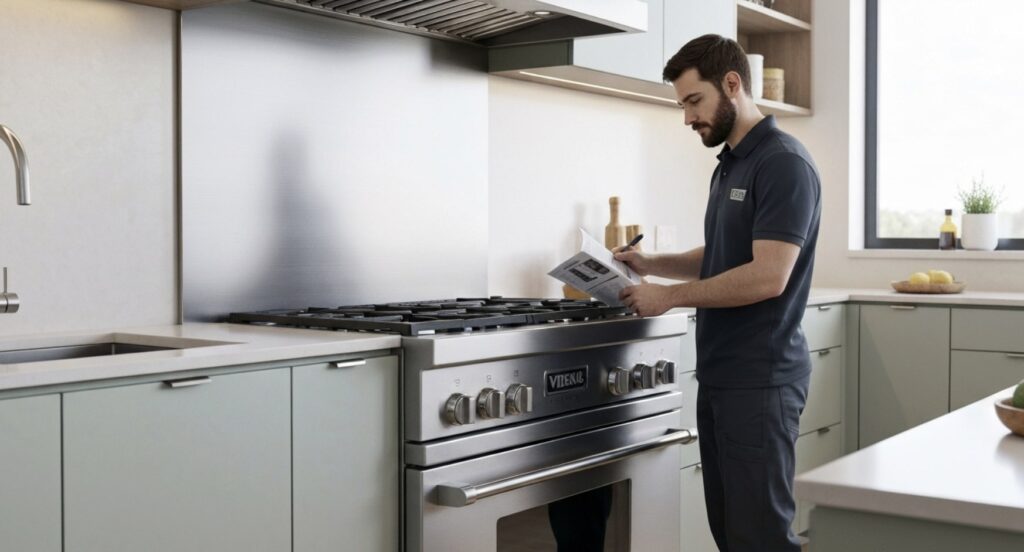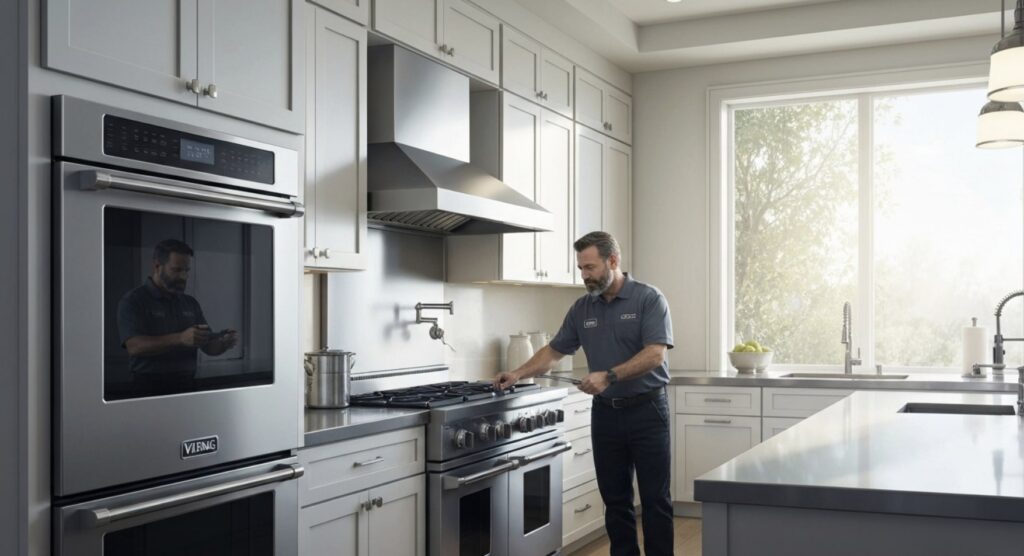After wildfires, it is very important to clean cooktops and rangetops. Ash and soot left behind can harm the surfaces if not cleaned quickly. Using the correct cleaning process is key to restoring the cooktop properly. Regardless of whether you have a Viking cooktop or another brand, good cleaning helps keep its look and use. Let’s explore how to clean cooktops and rangetops after wildfires to make sure your appliance stays in great shape.
Understanding the Impact of Wildfires on Cooktops and Rangetops
Wildfires can seriously harm cooktops and rangetops, especially Viking brands that have many parts. It is important to clean them well after a wildfire to stop any permanent damage. Soot and ash can get into delicate areas, which can harm how well the cooktops work and how long they last. To clean the cooktops properly, it’s vital to use the right cleaners and methods. Knowing how these high-end appliances work is very important to make sure you clean them well without causing more damage.
Types of Damage Caused by Ash and Soot
Ash and soot from wildfires can really hurt cooktops and rangetops. The tiny particles can get into the burner ports, block gas lines, and harm electrical parts. This can create safety risks. When soot combines with moisture, it makes a harmful mix that damages metal surfaces. This can lead to discoloration, rust, and even lasting damage to the appliance. Knowing the types of damage that can happen is important for cleaning and taking care of the appliance after wildfires.
The Importance of Gentle Cleaning Techniques
Gentle cleaning techniques are very important to keep your cooktop or rangetop safe after a wildfire. Use mild cleaners and avoid harsh tools. This helps stop damage to the sensitive surfaces of appliances like Viking cooktops. By picking a good cleaning process, you clean the cooktop well without hurting its function or look. Be careful when you treat the damaged areas. Pay attention to detail to bring your cooktop back to how it used to be. Remember, a gentle cleaning can really help your appliances last longer.
Step-by-Step Guide to Clean Gas Cooktops Post-Wildfire
Now you know the importance of cleaning cooktops and rangetops after wildfires, let’s move on to a step-by-step guide on how to clean gas cooktops post-wildfire.
Removing Ash and Soot Safely
Gently wipe off ash and soot with a soft cloth. This helps protect the cooktop surface from scratches. First, unplug the appliance to keep it safe. Use a vacuum with a brush to get rid of loose debris. Don’t use water at first to avoid spreading soot. If there is tough residue, you might want to use a cleaner suggested by the manufacturer. Remember to stay safe by wearing gloves and a mask during the cleaning process.
Natural Cleaners for a Spotless Finish
For a clean cooktop after a wildfire, use natural cleaners like vinegar or baking soda. These gentle cleaners can take away tough ash and soot without hurting your cooktop. Vinegar helps break down grease, and baking soda works well on hard stains. To get a shiny cooktop, include these eco-friendly options in your cleaning process.
Safety precautions before cleaning
- Wear protective gloves and a mask. This will help you avoid touching harmful residues.
- Make sure the area is well-ventilated while you clean. This helps prevent breathing in harmful particles.
- Turn off the gas supply to the cooktop before you start cleaning. This lowers the chance of accidents.
- Keep children and pets away from the cleaning area. This helps keep everyone safe.
Removing visible debris and ash from the cooktop
- Start by using a microfiber cloth. Gently wipe away any dust and ash from the cooktop surface.
- Make sure to clean all corners and edges where ash may collect.
- A soft brush or vacuum attachment can help remove tough residue without scratching the surface.
- Do not use harsh cleaners, as they may damage the cooktop’s finish.
- Regularly empty the debris collector or filter to keep cleaning efficient.
- Think about wearing gloves and a mask. This can help reduce direct contact with any harmful particles.
Using a degreaser or vinegar solution to clean the surface
When you need to clean up residue from wildfires on your cooktop, using a cleaner like a degreaser or a vinegar solution works well. These cleaners can remove tough dirt without harming the surface. To clean it, spray the cleaner on, let it sit for a few minutes, and then wipe it with a damp cloth. For a more thorough clean, mix equal parts water and vinegar, spray it on the cooktop, and wipe it off. This way, you can have a shiny cooktop without using harsh chemicals.
Cleaning and unclogging gas burners and grates
- Take apart the gas burners and grates gently for a proper cleaning.
- Soak them in warm, soapy water. This helps dissolve grease and dirt.
- Use a soft brush to scrub away any leftover bits.
- Make sure all parts are completely dry before putting them back together.
- Doing this regular maintenance helps the burners work well and keeps you safe.
Polishing and restoring the shine of the cooktop surface
Use a gentle cleaner that is safe for your cooktop surface. Softly polish it with a microfiber cloth to bring back its shine. Stay away from strong chemicals that can harm the cooktop’s finish. Keeping it clean with a special cleaner can help it look good for longer. Take steps to protect the surface from future injuries. A regular cleaning routine will keep your cooktop looking shiny and new. Use mild soap and non-scratch sponges to help maintain the shine.
Conclusion
In conclusion, it is very important to keep cooktops and rangetops clean after wildfires. By following our tips above on how to clean cooktops and rangetops after wildfires, you can ensure that your appliances are well-maintained and safe to use. Using gentle cleaners, regular cleaning routines, and proper maintenance techniques can help restore the shine and functionality of your cooktops. Remember to prioritize safety while cleaning and always follow the manufacturer’s instructions for maintenance. With a little care and attention, your cooktops will be looking as good as new in no time. For more appliance tips, check out our blog about Decoding Refrigerator Noises and What They Mean.
Frequently Asked Questions
How often should I clean my cooktop after a wildfire?
Cooktops need to be cleaned after a wildfire as soon as it is safe. Regular cleaning is important to stop more damage. Try to clean it well every few weeks or right away if you see any debris.
Are there any professional services recommended for cleaning cooktops and rangetops in such situations?
Professional cleaning services that focus on post-wildfire restoration can help with serious damage to cooktops and rangetops. They have the skills and tools to remove tough ash and soot. This way, they can clean everything properly without making the damage worse.
What steps can be taken to prevent long-term damage to Viking rangetops and cooktops after wildfires?
To avoid long-term harm after a wildfire, clean carefully. Remove all ash, use safe cleaners, and clear out burners. Make safety a priority by wearing protective gear and having good air flow. Regular upkeep can help keep the cooktop clean and working well.






